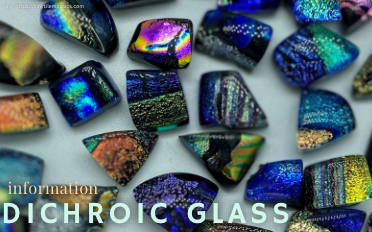Dichroic Glass | Stone Information, Healing Properties, Uses All Entries

Dichroic glass is a glass that shows a unique display of color changing iridescence depending on the light angle in which you are viewing it from. This material is created through a process of layering thin transparent glass with layers of metal oxides creating the color changing shift displaying a great example of thin-film optics. This incredible glass is used in many different ways, creating unique jewelry, home decor pieces in the form of plates, vases and many other forms of art.
Modern dichroic glass was explored and utilized by NASA when they began experimenting with treated glass to make astronaut face plates that would block astronauts from being affected by harmful spectrums of light. The metal oxides in the face plates fractured and separated the harmful lightwaves.
Although dichroic glass was thought to be a more recent creation, we found that this glass material first appeared in a couple pieces of Roman glass from the 4th century and consisted of transparents glass containing colloidal metals such as silver & gold! Though these pieces did not display as vibrant of colors as some dichroic glass pieces today, they displayed beautiful reflective color as certain wavelengths of light passed through them.
A great example of the 4th century dichroic glass is a piece displayed in the British Museum called the Lycurgus cup. This spectacular glass cup has an earthy green color when in normal front-directed light, but when a light is placed inside the glass or behind it, it transforms into a deep orchid purple color! Another fun fact about this is Dichroic glass gets its name from a Greek word meaning “two colors”.
In modern day manufacturing of this particular glass art, multiple ultra thin layers of transparent oxides such as titanium, chromium, aluminum, zirconium or magnesium are vaporized by an electron beam in a vacuum chamber. The vapor condenses on the surface of the glass. In the process of fusion, it creates a crystalline structure on the glass. The finished product may have as many as 50 layers of these materials, yet the thickness of the total coating is 30 to 35 millionths of an inch! Once that process is completed a thick layer of clear glass is placed on top to magnify the metal oxide layers and stabilize the piece so it can be used in many different applications.
Dichroic glass can reflect many different colors depending on what metal oxides were used in the creation process. You can identify what metal oxides were used just by looking at the colors with the piece. For example: The greens, teals and like colors are usually created by chromium, iron, zirconium or cadmium. While the deep blues and purples are created by oxides of manganese, copper or aluminum.



